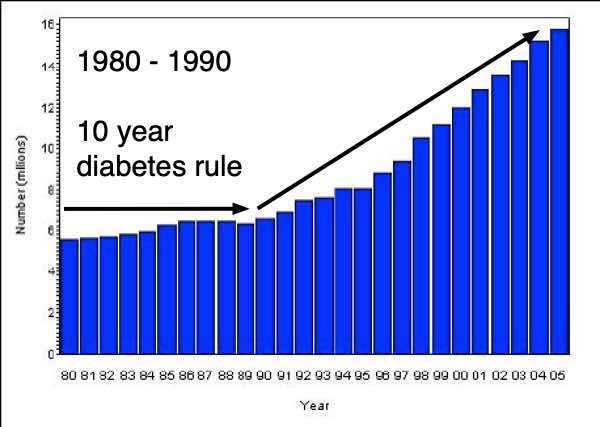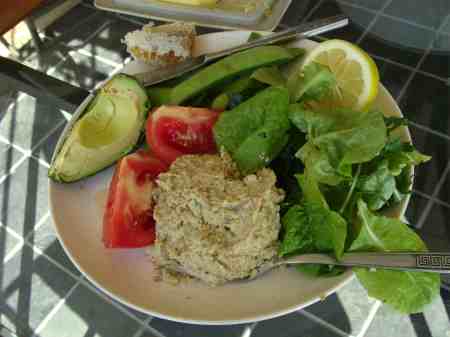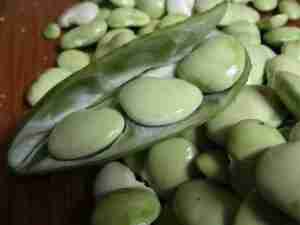- Bernard Preston homepage
- Starch
- Glycemic Response to Legumes
Glycemic response to legumes
This evaluation of the glycemic response to legumes weighs their place for those who are trying to shed pounds; are the chickpeas in hummus and the lima beans in succotash fattening? Can you enjoy lentils for their vegetable-protein without guilt? Will they add to your waistline?
Many of us are seriously confused about the role of starch in obesity.
There are so many diets fingering bread, potatoes and peas; are they
the cause of our steadily growing bellies? Is it true, or just fake news perhaps? Beans too have been bad-mouthed.
This page was last updated by Bernard Preston on 9th JulyQuic, 2025.
"Glycemic index refers to the extent of blood glucose elevation that occurs after the intake of any specific carbohydrate."
Dr M Misra, MD, MPH
 Will fresh green peas make Eggs Florentine fattening?
Will fresh green peas make Eggs Florentine fattening?You are probably concerned when you read reports that twice as many people on the planet are dying from obesity as from starvation; that is not fake-news but solid fact. Life is good and you really have no desire for it all to end ten or more years before it should.
And that was pre-Covid; it's probably now three times. The bug has been targeting the obese; chronically raised blood glucose causes generalised inflammation in the body making us vulnerable to viral attack.
It is also makes the red blood corpuscles sticky; blockages in both the capillaries and great vessels become more likely.
Add to that those aching knees and feet; you have a deep-sense that all is not well in the state of Denmark.
"Time to get off my fat-ass and onto my dying feet."
- Dr Dune
Glycemic response to legumes
Can you eat green peas; or should you be avoiding them? The answer is to be found in the glycemic response to legumes. This is especially important if your doctor has mentioned that you have become insulin-resistant.
If you are unsure find out more from our page about legumes[4].
"Instead we need to look at our meals as a whole; if we reduce the amount of one food, it is important to choose a nutritious and sensible replacement."
- Cardiovascular Research, July, 2021.
Biochemistry of carbs
Let us look at some basic biochemistry.
Carbs consist of long chains of glucose molecules; some are digested rapidly in our small intestines, very lengthy compared to most primates. Others, especially the "the resistant starches" and fibre pass right through to the colon where they are slowly fermented to form important short-chain fatty acids rather than sugars.
Starches like baked potatoes, white rice and commercial bread rolls are quickly digested in the small intestine giving a sharp rise in blood sugar; so too broad beans that have been skinned. There is a high glycemic response that must be counteracted by the pancreas giving a squirt of insulin.
That glucose is then rapidly stored in adipose tissue; unless you are insulin-resistant. Then your blood sugar will rise and you may soon be needing Metformin or the hormone jabs for the rest of your life; or one of the new generation exceedingly expensive GLP-1 drugs.
And of course chocolate cake is tops; sugar and white flour make for a disaster. Together they invoke the ten year diabetes law. Just one slice has 32g of starch and almost no fibre; net carbs are very high. That's more than an insulin-resistant person should have in a whole day; and how many of us can refuse a second helping?
High serum-glucose is very dangerous for the arterial lining; allowed to continue it causes inflammatory changes. That leads to blindness and loss of limbs as the blood doesn't get through to the organs. So the body tries to store it as adipose.
Diabetes, carbs and legumes

The problem arises when your body either cannot produce the hormone, called type 1 diabetes or you have become insulin-resistant, T2D. Blood sugar rises and there is a real threat to both the quality and length of life.
Well over 10% of adults in Western countries fall into one of these two-categories; and the numbers are rising fast. More than half are walking the streets undiagnosed and unaware that their very lives are threatened. Sudden death from heart attack or stroke lies in wait; or a malignant tumour.
Could you be one of them?
Two groups of South Africans adults, the Indians and Cape Coloureds have a diabetes prevalence approaching one-third[1]. It explains in part why we are officially one of the ten most unhealthy nations on the planet; and that viruses are knocking so many holes in our communities.
Almost three quarters of those that fell to the dreaded Covid bug had chronically raised blood glucose. It contributes to what is known as a cytokine storm; an over-exuberant inflammatory reaction to the virus.
Osteoporosis, carbs and legumes
A high GI diet is associated with an acute rise in glucose and insulin levels.
That causes oxidative stress and the secretion of inflammatory cytokines such as interleukin 6 and tumor necrosis factor alpha; that activates cells that increase bone loss.
- Dr M Misra, MD, MPH
You've probably read that if you are overweight you quite likely could be prone to osteoporosis; a simple blood-test will answer the question. However, interpretation of the results of those markers differs widely from one doctor to another. The best is the HbA1c.
Yesterday I had a patient whose GP told her that a HbA1c of 7.3 should be of no concern. Most medical authorities state it should be below 6.5%.
So you know you have a problem; and chocolate-cake and colas are verboten but what is the glycemic response to legumes? Are peas and beans also banned? Can you enjoy hummus on your green salad?
"Those foods that are good for you include whole-grains, fruits and veggies; legumes and nuts too."
- Cardiovascular Research, July 2021.
 Hummus with a green salad. What about a piece of honeycomb?
Hummus with a green salad. What about a piece of honeycomb?Glycemic response to legumes
This essay on the glycemic response to legumes considers whether the obese and diabetics should be avoiding beans, peas and other pulses rich in protein; but with some carb content too.
Legumes are sometimes sneered at, being called the poor man's meat. Like all half truths that is partially correct. Peas, beans and lentils are much cheaper sources of protein than beef.
But beans are very starchy is the oft-heard cry. They will make me fat.
The other half of the truth though is that they are a far healthier form of protein; and in any case because of cost and the availability of water, within fifty-years the population explosion will mean that only the very rich will be able to afford much red meat.
Just like the wealthy in Indonesia died in their millions from a vitamin B1 deficiency from eating white rice but the poor had to rely on the unpolished grain; so the chronic degenerative diseases from our lust for ultra-refined foods in the Twenty First Century are killing us today.
The point made by this page on the glycemic response of legumes though is that foods like chickpeas are not only a good source of vegetable protein but also of slow-release carbohydrate. They have a higher proportion of amylose which, because of its helical structure is a "resistant starch."
Much passes through the small intestine undigested reaching the colon, giving it bulk and healthy short-chain fatty acids like butyrate are formed; important markers of the happy gut.
Newsletter
Our newsletter is entitled "create a cyan zone" at your home, preserving both yourself and Mother Earth for future generations; and the family too, of course. We promise not to spam you with daily emails promoting various products. You may get an occasional nudge to buy one of my books.
Here are the back issues.
- Lifestyle and ideal body weight
- What are ultra-processed foods?
- Investing in long-term health
- Diseases from plastic exposure
- Intensive lifestyle management for obesity has limited value
- A world largely devoid of Parkinson's Disease
- The impact of friendly bacteria in the tum on the prevention of cancer
- There's a hole in the bucket
- Everyone is talking about weight loss drugs
- Pull the sweet tooth
- If you suffer from heartburn plant a susu
- Refined maize meal and stunting
- Should agriculture and industry get priority for water and electricity?
- Nature is calling
- Mill your own flour
- Bake your own sourdough bread
- Microplastics from our water
- Alternative types of water storage
- Wear your clothes out
- Comfort foods
- Create a bee-friendly environment
- Go to bed slightly hungry
- Keep bees
- Blue zone folk are religious
- Reduce plastic waste
- Family is important
- What can go in compost?
- Grow broad beans for longevity
- Harvest and store sunshine
- Blue zone exercise
- Harvest and store your rainwater
- Create a cyan zone at your home
Glycemic response to legumes
So what is the glycemic response to legumes? Harvard Medical School says the indices for chickpeas, kidney beans and lentils are all around 30; very low.
The one exception is favas which are surprisingly high because people unwisely skin the beans. For the rest there is no insulin rush; and no instant deposit of glucose as adipose.
I would be reluctant to exclude fava beans for many other reasons but rather use the small-seed varieties like Gobik and Goral which have a significantly higher resistant starch content; that slows the action of the enzymes in the gut. They then reach the colon for fermentation by the microbiota. Enjoy them green and young straight from the garden; never skin them.
Favas are also known as broad beans; they are the only known source of L-dopa and are vitally important in the management and prevention of Parkinson's disease. They also have the greatest amount of vegetable protein (25%) of all legumes after soy.
Sprouting dried broad beans is also a good option.
Legumes in various dietary protocols
Legumes are banned in various dietary protocols like Banting, Adkins and Paleo. That is partly because of their starch content, despite the fact they give no abnormal "postprandial" rise in blood-sugar in those not suffering from diabetes.
It needs to be stressed that starch GIs, how quickly they are digested and absorbed in the small intestine, have all been tested on healthy people. Diabetics and those who are insulin-resistant may respond very differently; in fact they probably do, as the glucose transporters in the blood and the liver ensure higher levels of serum sugar.
The Paleo diet goes so far as to call legumes anti-nutrients because of their phytate content.
Type "what are phytates" into Site Search for more information.
All three of these diets recommend high red-meat consumption; even if the total exclusion of all legumes is effective in losing weight, there will be a far greater risk of dying from a neoplasm instead. Without the fibre the bacteria in the gut will starve.
So would you rather die from a heart attack or cancer?
Personally I am convinced the very-low glycemic response of legumes, with the exception of fava beans if you skin them far outweighs any deleterious effect of the starch for those dieting. Cooked with chili, ginger and garlic they are simply delicious.
Best of all legumes have a very high satiety factor; they do not leave you feeling famished mid-morning. You won't be reaching for cookies and a cola.
Read more about glycemic index[2].
Peanuts are a rich source of dietary protein for stunted children suffering from kwashiorkor; oddly they are often also obese.
The dilemma is whether the carbs in peanut butter would also contribute to their weight problems.
Lentil potage
This simple lentil potage is just a thick vegetable soup with a very low glycemic response; the meat lover can easily add a pork sausage. If you believe all the hype about anti-nutrients then simply use green legumes rather than those that have been dried.
- Don't fear anti-nutrients[3].
You will probably have to grow your limas which I recommend in any case; they are far nicer and better than butter-beans from a can.
Much of it has to do with your philosophy. We are totally committed to creating a Cyan Zone at our home, caring for both the planet and our own wellness; that implies green and blue issues. That means eating large amounts of legumes for protein daily.
The cattle for red meat add far more carbon to the atmosphere than growing legumes like lima beans; and demand ten-times as much water.
 Green beans are far nicer and have less anti-nutrients.
Green beans are far nicer and have less anti-nutrients.In answer to the question raised in the opening paragraphs, we recommend only new potatoes and sourdough bread. They too have a low GI.
"They who do not live by the truth they acknowledge, thereby become the greatest enemies of truth itself."
- Julius Rupp, 19th Century Lutheran pastor
- High prevalence of diabete mellitus and metabolic-syndrome in a South African coloured population
- Glycemic index @ Sydney University
- Don't fear anti-nutrients @ Tufts University
- What are legumes?
When browsing use right click and "Open Link in New Tab" or you may get a bad gateway signal.
Did you find this page interesting? How about forwarding it to a friendly book or food junkie? Better still, a social media tick would help.
- Bernard Preston homepage
- Starch
- Glycemic Response to Legumes
Address:
56 Groenekloof Rd,
Hilton, KZN
South Africa
Website:
https://www.bernard-preston.com